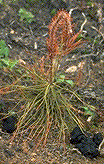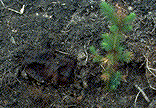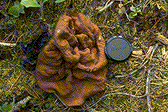Archived Content
Information identified as archived on the Web is for reference, research or recordkeeping purposes. It has not been altered or updated after the date of archiving. Web pages that are archived on the Web are not subject to the Government of Canada Web Standards. As per the Communications Policy of the Government of Canada, you can request alternate formats on the Contact Us page.
Rhizina Root Rot
Rhizina undulata Fr.:Fr.
(= Rhizina inflata (Schaeff.) P. Karst.)
Ascomycotina, Pezizales, Helvellaceae
Hosts:Rhizina undulata has been reported in B.C. on western redcedar, Engelmann, Sitka, and white spruce, lodgepole pine, Douglas-fir, western larch, and western hemlock. In other parts of North America, it has also been found on western white pine and grand fir.
Distribution: This disease is prevalent in recently burned sites throughout the province, particularly in the CWH and Interior Cedar Hemlock biogeoclimatic zones.
Identification: Affected seedlings exhibit discoloured foliage or mortality, symptoms similar to other root rots or drought damage (Fig. 7a). Seedlings may be girdled at the root collar. The presence of fruiting bodies (apothecia) within 0.5 m of affected hosts is a good indicator of disease. Apothecia are brown-black, and have a tough, fleshy upper surface that is irregularly lobed and undulating (Fig. 7b). The undersurface is tan-ochre with whitish, cylindrical, branched root-like structures, 1-2 mm thick. The fruiting bodies vary in size, up to 6 cm wide, and may grow together to form a larger mass.
Microscopic Characteristics: Asci about 400 x 15 µm, J-, ascospores 8/ascus, fusiform with two or more oil drops and a hyaline apiculus at each end, rough, 22-40 x 8-11 µm.
Damage: Outbreaks of the disease are sporadic, but the mortality of up to 80% of seedlings has been reported in newly established plantations, following site preparation burns. One study reported Rhizina in one third of 160 stands surveyed in B.C.
Remarks: In B.C., Rhizina root rot is mainly a disease of young seedling in plantations that have been slashburned within 2 years. In other parts of the northern hemisphere, the fungus is known to affect all ages of trees, but is always associated with recent fire activity. Damage might be avoided at high risk sites by delaying planting for two or more years after burning. No chemical or biological controls have been developed. R. undulata is sometimes confused with other ascomycete fungi, particularly Gyromitra species (Fig. 7c).
References:
Callan, B. E. 1993. Rhizina root rot of conifers. For. Can., Forest Pest Leaf. No. 56. Victoria, B.C.
Ginns, J. H. 1973. Rhizina root rot: severity and distribution in British Columbia. Can. J. For. Res. 4:143-146.
Figures
Click on any image to see the full size version.
Press "Back" on your browser to return to this screen.

Figure 7a: Seedling mortality and fruiting bodies of Rhizina undulata.
 Figure 7b: R. undulata fruiting body.
Figure 7b: R. undulata fruiting body.
 Figure 7c: Gyromitra sp. Sometimes confused with R. undulata, this fungus does not damage seedlings.
Figure 7c: Gyromitra sp. Sometimes confused with R. undulata, this fungus does not damage seedlings.
 This Web page has been archived on the Web.
This Web page has been archived on the Web.